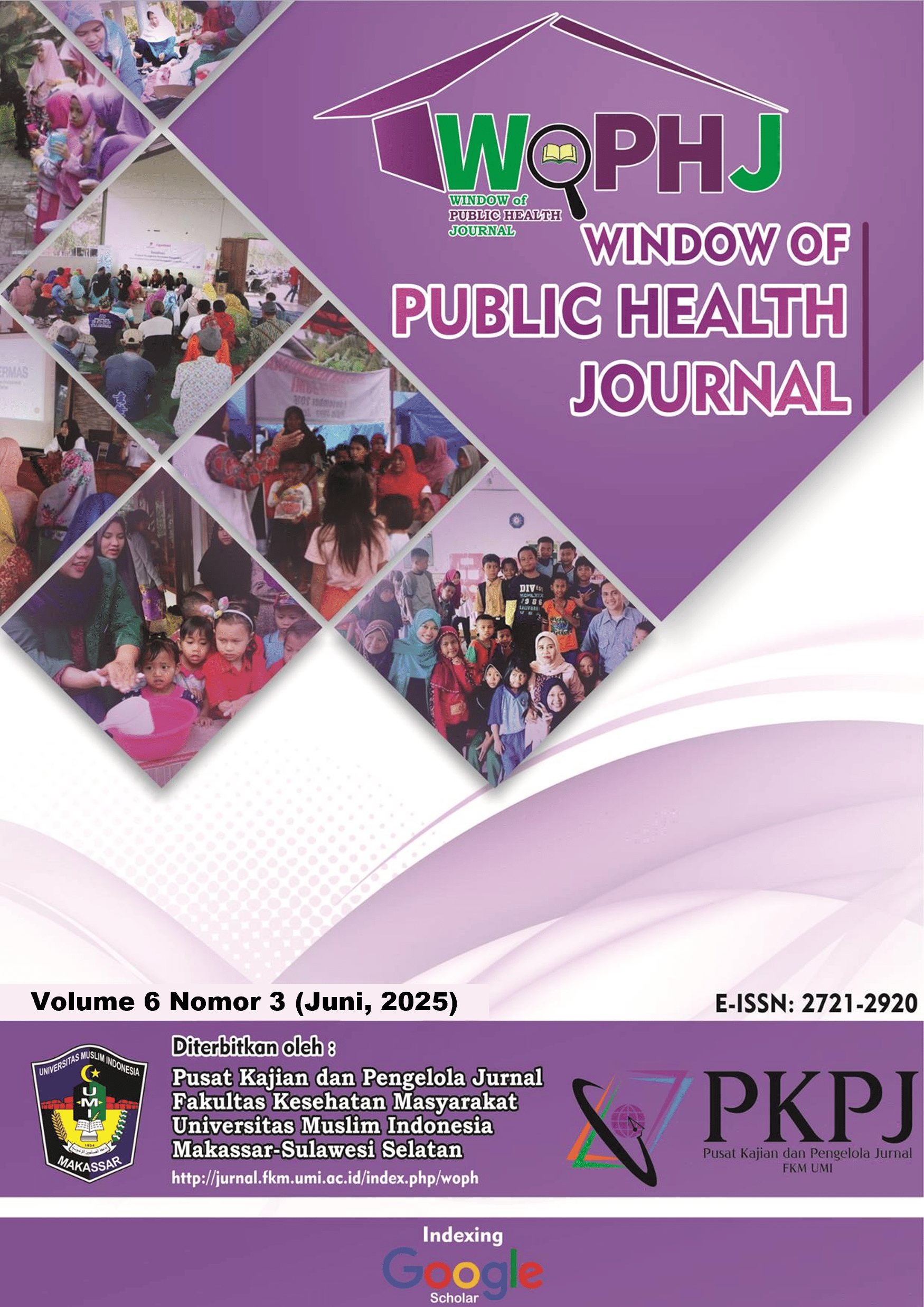Hubungan Penerapan 4 Indikator PHBS Dengan Kejadian Demam Tifoid di Dusun Abbanuangnge Desa Bila Kecamatan Dua Pitue Kabupaten Sidenreng Rappang
DOI:
https://doi.org/10.33096/8ftg6v68Keywords:
Clean and healthy living behavior, Thypoid fever, Washing handsAbstract
Clean and Healthy Living Behavior Program for households, Tanrutedong Health Center, had coverage in 2020 of (67%); in 2021, there was a decrease in coverage (56%). For the minimum target of PHBS itself, it has a target achievement of (70)%. The problems that arise include the three highest diseases in the Tanrutedong Health Center, one of which is 90% Typhoid Fever. This study aims to determine the relationship between the implementation of 4 PHBS indicators and the incidence of typhoid fever in Abbanuangnge Hamlet, Bila Village, Dua Pitue District, Sidenreng Rappang Regency in 2022. This type of research is Observational Analytical research with a Cross-Sectional Study approach; this research will be conducted in August and September 2022. The sampling technique in this study uses non-probability sampling in the form of accidental sampling. The population in this study included families in Abbanuangnge Hamlet, Bila Village, Dua Pitue District, and Sidenreng Rappang Regency. There were as many as 171 families, with the Slovin formula of 121 families. The results of the study showed that the use of clean water (p = 0.527) had no relationship with the implementation of typhoid fever, washing hands with clean water and soap (p = 0.391) had no relationship with the implementation of typhoid fever, using healthy toilets (p = 0.560) had no relationship with the implementation of typhoid fever, and eating fruits and vegetables every day (p = 781) had no relationship with the implementation of typhoid fever. The study concluded that there was no relationship between implementing clean water, washing hands with clean water and soap, using healthy toilets, and eating fruits and vegetables every day with typhoid fever. It is hoped that the community will always pay attention to clean and healthy living behaviors to avoid typhoid fever.
References
1. Zulkoni A. Parasitologi. Yogyakarta: Nuha Medikal; 2018
2. Kementrian Kesehatan RI. Antisipasi Penyakit Menular Saat Banjir. Jakarta: Direktorat Jendral Penyakit dan Penyehatan Lingkungan; 2019
3. Aspina L. Cara Penularan Penyakit Tipes. Jakarta: Kompasiana; 2020
4. WHO. Weekly Epidemiological Record [Internet]. 2018 [Cited 21 Agustus 2022]. Available from : https://polioeradication.org/tools-and-library/policy-reports/who-weekly-epidemiological-record/
5. Radhakrishnan, A., Als, D., Mintz, E.D., Crump, J.A., Stanaway, J., Breiman,R.F., Bhutta, Z.A. Introductory Article on Global Burden and Epidemiology of Typhoid Fever. Urban Health [Internet] 2018;9(1):4-9. [Cited 17 Agustus 2022]. Available from : https://doi.org/10.4269/ajtmh.18-0032
6. Kementerian Kesehatan RI. Laporan Provinsi Riskesdes Nasional 2017. Lembaga Penerbit Badan Litbang Kesehatan; 2017
7. Maryunani A. Perilaku Hidup Bersih dan Sehat (PHBS). Jakarta: Trans Info Media; 2021
8. Wulandari P. Hubungan Antara Perilaku Hidup Bersih dan Sehat dengan Kejadian Demam Tifoid Diwilayah Kerja Puskesmas Upai Kota Kotamobagu. Fakultas Kesehatan Masyarakat Universitas Sam Ratulangi Manado [Internet] 2020:5(1);46-52 [Cited 17 September 2022]. Available from :
https://ejournal.unsrat.ac.id/v3/index.php/pharmacon/article/download/12215/11794/24340
9. Natsir M. Perilaku Hidup Bersih dan Sehat (PHBS) pada Tatanan Rumah Tangga Masyarakat Desa Parang Baddo. Fakultas Kesehatan Masyarakat Universitas Hasanuddin Makassar [Internet] 2019:1(3);54-59. [Cited 01 Oktober 2022]. Available from : https://journal.unhas.ac.id/index.php/jnik/article/view/6120
10. Maria E, Supriadi. Hubungan Kebiasaan Mencuci Tangan Menggunakan Air Bersih dan Sabun dengan Kejadian Demam Thyfoid Pada Orang Dewasa Di Wilayah Kerja Puskesmas Dinoyo. Fakultas Ilmu Keperawatan Universitas Tribhuwana Tunggadewi [Internet] 2019:4(2);17-28 [Cited 04 Oktober 2022]. Available from : https://publikasi.unitri.ac.id/index.php/fikes/article/view/1546
11. Eunike R, Henry P. Hubungan Personal Hygiene Dengan Kejadian Demam Tifoid di Wilayah Kerja Puskesmas Tumaratas. Fakultas Kedokteran Univesitas Sam Ratulangi [Internet] 2018:3(1);82-91. [Cited 04 Oktober 2022]. Available from : https://doi.org/10.35790/jkp.v3i2.7449
12. Rahmawati. Perilaku Hidup Bersih dan Sehat (PHBS). Yogyakarta : Nuha Medika; 2017
13. Syamsuddin. Penerapan Sanitasi Total Berbasis Masyarakat (STBM) Pilar 1 Stop Buang Air Besar Sembarangan (Stop Babs) Dengan Kejadian Penyakit Diare Di Kelurahan Lakkang Kecamatan Tallo Kota Makassar. Fakultas Kesehatan Lingkungan Poltekkess Kemenkes Makassar [Internet] 2019:13(2);109-119. [Cited 14 Oktober 2022]. Available from : http://www.journal.poltekkes- mks.ac.id/ojs2/index.php/Sulolipu/article/view/1035
14. Kasim D. Faktor-Faktor yang Mempengaruhi Rendahnya Penggunaan Jamban Pada Masyarakat Pesisir Desa Bulontio Barat Kecamatan Sumalata Kabupaten Gorontalo Utara. Fakultas Kesehatan Masyarakat Universitas Negeri Gorontalo [Internet] 2021:5(1);1-14 [Cited 14 Oktober 2022]. Available from :https://www.neliti.com/publications/37232/faktor-faktor-yang-mempengaruhi-rendahya-penggunaan-jamban-pada-masyarakat-pesis
15. Promosi Kesehatan. Panduan Makan Sayur dan Buah Setiap Hari. [Internet]. 2020 [Cited 21 Agustus 2022]. Available from : https://promkes.kemkes.go.id/?p=7412
Downloads
Published
Issue
Section
License
Copyright (c) 2025 Nurfadillah, Fatmah Afrianty Gobel, Sartika

This work is licensed under a Creative Commons Attribution-NonCommercial-ShareAlike 4.0 International License.







